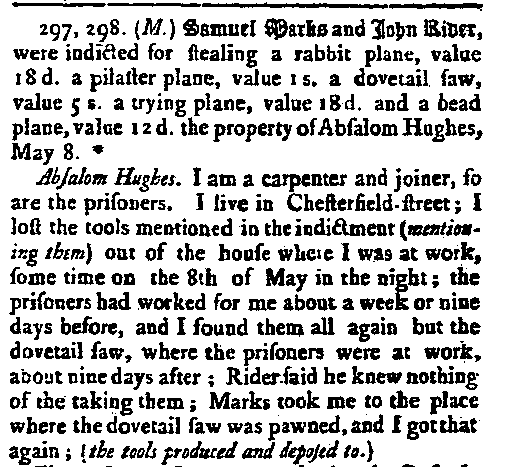| | 12/12/2008 |  With all the hoopla about old saws lately it's easy to forget that once there were a lot of saws out there and tools were valuable. In the course of designing our Gramercy dovetail saw and the new Gramercy carcase saws we spent tons of time just doing homework. Once, just for jollies I thought I would see how many times dovetail saws were involved in felony cases at the Old Bailey. The Old Bailey was, and is, London's central court for felony crimes of all sorts. With all the hoopla about old saws lately it's easy to forget that once there were a lot of saws out there and tools were valuable. In the course of designing our Gramercy dovetail saw and the new Gramercy carcase saws we spent tons of time just doing homework. Once, just for jollies I thought I would see how many times dovetail saws were involved in felony cases at the Old Bailey. The Old Bailey was, and is, London's central court for felony crimes of all sorts.
Read the cases. They are all sort of depressing and sad, 5 shillings was more than a good journeymen's wage for a day or so at the time. And a guilty verdict could get you hung or deported to the colonies (Georgia in the US for one).
Samuel Marks; John Rider; Theft > grand larceny; 3rd June 1767.
JAMES GRAY; Theft > grand larceny; 14th September 1796.
GEORGE BOYER; Theft > grand larceny; 18th February 1801.
JOHN ROBINSON; Theft > grand larceny; 23rd May 1798.
WILLIAM ARROW; Theft > grand larceny; 29th October 1806.
WILLIAM SIDAY; WILLIAM PARIS; Theft > housebreaking; 3rd June 1772.
I have done lots of searches for tool related crimes. These folks were mostly acquitted but one pair got death. But during my tool searches it's routine to come across all sorts of crimes using tools. Some heartbreaking, some stupid, and some just plain curious. It's fascinating to me that what would be a nuisance crime for us today-- where the police would be happy to just see the goods restored to the correct owner-- was then a major (if speedy) court case. It's a real slice of life from 18th century London. The Old Bailey only tried felony cases. As far as I know, civil cases from other courts have not been put on-line. I bet those will be even more interesting.
| Join the conversation | |
| The opinions expressed in this blog are those of the blog's author and guests and in no way reflect the views of Tools for Working Wood. |
|
 Joel's Blog
Joel's Blog Built-It Blog
Built-It Blog Video Roundup
Video Roundup Classes & Events
Classes & Events Work Magazine
Work Magazine


 With all the hoopla about old saws lately it's easy to forget that once there were a lot of saws out there and tools were valuable. In the course of designing our
With all the hoopla about old saws lately it's easy to forget that once there were a lot of saws out there and tools were valuable. In the course of designing our
Interesting slice of history! You think Siday and Paris would have been able to plea bargain down if it wasn't for the dovetail saw in the loot? And why didn't they just ask for a bailout if they needed some help?
Rob
Of course the plane is wood, not metal - so a C & W 22" trying plane for comparison is $385. These are hand made, however so are the Gramercy/Adria/Wenzloff saws (dovetail $135-140). The Primus try plane is $270, and the HNT Gordon is $240 - perhaps these are a better comparison?
The second hand market is a bit thin for 18th C, so looking at mid 19th C and one would expect to pick up a good dovetail saw for $50, a trying plane perhaps a fraction cheaper.
Perhaps a better comparison is the 1930 Buck & Hickman catalogue:
22" try plane 13/8
10" best quality brass back saw 6/- (Disston No 4 was 10/-, showing the decline in British saws perhaps?)
and the 1909 Preston catalogue:
22" try plane 6/9
10" best quality brass back saw 6/-
So saws are progressively relatively cheaper over time. Listed is the cost of a try plane as % of dovetail saw:
1767 30%
1909 112%
1930 228%
2008 280% C & W
192% Primus
171% HNT Gordon
One can understand the cost of spring steel in 1767; and by the early 20th C this should not be a significant issue - and we see this in the disappearance of the price gap by 1909. The big reversal in price gap appears between 1909 and 1930, with (perhaps) a smaller jump to 2008. Is this early 20th C jump caused by the increased price (and lesser availability) of suitable timer? Or is there more (or more expensive) labour today (and in the early-mid 20th C) in a wooden plane compared to the 19th C?